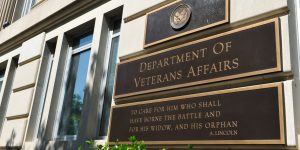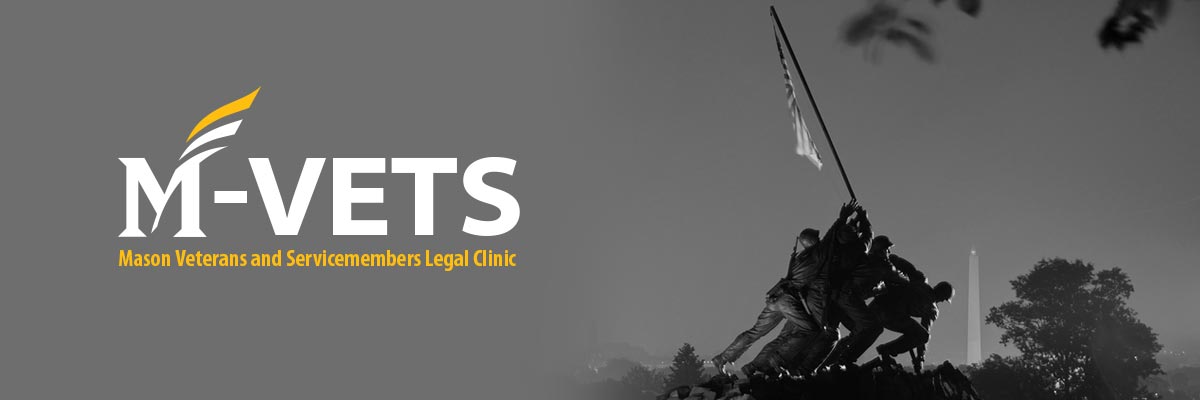
Written by M-VETS Student-Advisors Mike West and Fernando Cota-Wertz
“To care for him who shall have borne the battle and for his widow, and his orphan.” That is the official motto of the U.S. Department of Veteran’s Affairs.[1] The Department of Veterans Affairs, or the VA for short, is the Federal Department tasked with taking care of our Nation’s Veterans and their families. Yet, recent studies have found that “more than a half million veterans in the United States are homeless at some time, and on any given night more than 300,000 are living on the streets or in shelters.”[2] “Although lack of education and limited transferable skills from military to civilian life are significant causes of these problems, physical and mental health problems (and lack of care for those problems) are also factors.”[3] With physical and mental health problems weighing in as two major factors causing significant struggles for veterans and servicemembers to adapt to civilian life, the lack of care for these problems needs to be addressed.
The Military Times, in an article published on June 3, 2016, reported that in the past five months about 505,000 veterans were still waiting more than a month to see a doctor.[4] The problem is even worse for Veterans seeking mental health treatment. The American Physiological Association estimates that of the 1.7 million veterans that served in Iraq and Afghanistan, 300,000 suffer from Post Traumatic Stress Disorder or major depression.[5] It is also estimated that over twenty veterans commit suicide every day.[6]
In order to combat this epidemic, the VA has aggressively undertaken new measures to combat suicide among Veterans. VA facilities now have same-day access for veterans who suffer from mental health issues.[7] Additionally, the VA has hired 5,300 new mental health providers since 2010 and it is launching new community initiatives to try to get counseling to the Veterans in need.[8] The VA is also developing and utilizing preventive modeling systems so it can identify high-risk veterans in order to intervene as early as possible.[9] VA officials are hopeful that this new preventive research will give them a better idea of where to focus their efforts.[10]
In additions to its efforts to help Veterans in need of mental health treatment, the Federal Government has also put into place other programs to help combat the “backlog” at the VA. One of these programs is the Veterans Choice Program (VCP). The VCP tries to circumvent the long wait times by allowing veterans to see a private physician if they are not able to get an appointment at a VA in fewer than 30 days.[11] “For Veterans who have faced unacceptable waiting times for needed medical care, or for whom a regular VA medical facility is inaccessible, the Veteran Choice Program makes it possible for them to receive the needed care from a non-VA health care provider in their community.”[12] In order to use the VCP, veterans must enroll in the program.[13] After enrolling, veterans will receive a Veterans Choice Card and receive a letter detailing information about their eligibility.[14]
So far, it seems that the VCP has not done much to alleviate the problem of wait times. It has been reported that the VCP has had little impact on getting veterans to see a primary care physician within 30 days.[15] Veterans are facing problems such as being referred to doctors that are too far away, not being placed on the list of patients eligible for the VCP, and being denied service due to the VCP not paying doctors on time.[16] A lot of the problems with the VCP may be due to the quick implementation time of the program. The VCP, essentially a $10 billion program, was basically created in 90 days. Usually a program of this size and complexity takes at least a year to create and have proper implementation. The government needs to continuously updated and modify the procedures of the VCP to help decrease the wait time for veterans. Due the fast implementation of the program, a lot of modification needs to continuously be implemented in the program until veteran wait time is drastically reduced.
The VCP needs to implement a directional plan to help decrease wait times in problem areas. Some hospitals’ clinics have no wait times.[17] While at other facilities, veterans can wait months. The VCP should reform to target theses problem areas first. They should seek to enroll more local doctors in the problem areas by incentivizing local doctors to join. For example, the government could offer some sort of tax credit for funds earned treating veterans based on participation in the VCP. An incentive like this may help to get more doctors involved and result in decreased wait times in problem areas, and ultimately increase the effectiveness of the VCP in general.
“With the words, ‘To care for him who shall have borne the battle and for his widow, and his orphan,’ President Lincoln affirmed the government’s obligation to care for those injured during the war and to provide for the families of those who perished on the battlefield.”[18] Though the federal government has put into place programs to help alleviate the various veteran health care problems, it still can do a better job at making sure veterans are able to receive proper health care in a timely manner. With physical and mental health problems weighing in as two major factors causing significant struggles for veterans and servicemembers to adopt to civilian life, timely medical services and care can help them to adopt more easily to civilian life.
[1] The Origin of the VA Motto: Lincoln’s Second Inaugural Address, United States Department of Veterans Affairs, https://www.va.gov/opa/publications/celebrate/vamotto.pdf
[2] Policy Statement, Am. Public Health Ass’n, Removing Barriers to Mental Health Services for Veterans (Jan. 2015).
[3] Policy Statement, Am. Public Health Ass’n, Removing Barriers to Mental Health Services for Veterans (Jan. 2015).
[4] Kime, Patricia, Some veterans still wait months for medical care, Military Times, June 3 2016, http://www.militarytimes.com/story/veterans/2016/06/03/some-veterans-still-wait-months-medical-care/85350810/
[5] American Physiological Association: The Critical Need for Mental Health Professionals Trained to Treat Post-Traumatic Stress Disorder and Traumatic Brain Injury, January 1, 2016: http://www.apa.org/about/gr/issues/military/critical-need.aspx (quoting RAND Center for Military Health Policy Research, Invisible Wounds of War, 2008.)
[6] Id.
[7] McLaughlin, Elizabeth, Va Releases Results of Largest Analysis of Veteran’s Suicide Rates, ABC News, July 7, 2016, http://abcnews.go.com/US/va-releases-results-largest-analysis-veteran-suicide-rates/story?id=40401007
[8] Kime, Some Veterans Still Wait Months For Medical Care, June 3, 2016.
[9] McLaughlin, Va Releases Results of Largest Analysis of Veteran’s Suicide Rates, July 7, 2016.
[10] Kime, Some Veterans Still Wait Months For Medical Care, June 3, 2016.
[11] Id.
[12]Veterans Affairs Program, Health Net Federal Services, LLC., October 27, 2016, https://www.hnfs.com/content/hnfs/home/va/home/veterans-choice/what-is-the-veterans-choice-program-.html
[13] Id.
[14] Id.
[15] Walsh, Steve, Lawrence, Quil, Pupovac, Jessica, How Congress and the VA left Many Veterans Without a ‘Choice,’ NPR, May 17, 2016, http://www.npr.org/2016/05/17/478215589/how-congress-and-the-va-left-many-veterans-without-a-choice
[16] Id.
[17] Kime, Some Veterans Still Wait Months For Medical Care, June 3, 2016.
[18] Celebrating America’s Freedoms: The Origin of the VA Motto Lincoln’s Second Inaugural Address, U.S. Department of Veterans Affairs, October 28, 2016, https://www.va.gov/opa/publications/celebrate/vamotto.pdf
